Crispy fried cornbread combines the beloved flavor of traditional cornbread with an irresistible golden-brown crust. This Southern specialty transforms simple ingredients into a versatile side dish that pairs perfectly with everything from chili to collard greens. Unlike baked cornbread, the crispy fried cornbread offers a delightful textural contrast – crunchy exterior giving way to a tender, slightly sweet interior that captures the essence of Southern comfort food at its finest.
Table of Contents
The Magic of Crispy Fried Cornbread
What sets crispy fried cornbread apart from its baked counterpart is the cooking method. When cornmeal batter meets hot oil, the exterior quickly develops a crisp shell while the inside stays moist and tender. This cooking technique allows for individual portions that maximize the crispy-to-soft ratio in every bite. The result is a more textural experience that many find irresistible.
Whether you call them “hoe cakes,” “johnny cakes,” or simply “crispy fried cornbread,” these golden discs have been gracing Southern tables for generations. Their humble origins speak to resourcefulness – a simple way to stretch pantry staples into a satisfying meal component that could be prepared quickly over any heat source. Native Americans were making corn cakes long before European settlers arrived, and the technique was adopted and adapted through centuries of cultural exchange.
A Brief History of Fried Cornbread
The story of crispy fried cornbread is deeply intertwined with the history of the American South. Indigenous peoples throughout the Americas cultivated corn and created various forms of cornmeal cakes. When European settlers arrived, they adopted these cooking methods out of necessity and availability of ingredients.
During times of scarcity, particularly in rural areas and during the Civil War, cornmeal became an essential staple. Cooking it in small portions in a skillet over an open fire was practical and efficient. The name “hoe cake” allegedly derives from the practice of cooking the cornmeal batter on the flat metal blade of a field hoe over an open flame when proper cooking implements were unavailable.
African American culinary traditions further enriched the development of crispy fried cornbread. During slavery and afterward, African Americans transformed limited ingredients into nourishing, flavorful dishes. Their expertise helped shape what we now recognize as Southern cuisine, including various forms of fried cornbread that became staples at the table.
In contemporary Southern cooking, crispy fried cornbread remains a cherished dish, representing both heritage and the simple pleasure of perfectly executed comfort food. Unlike its Northern counterpart, which tends to be sweeter and more cake-like, Southern fried cornbread emphasizes the natural flavor of corn, with just enough sweetness to enhance rather than overwhelm.
Ingredients for Perfect Crispy Fried Cornbread
The beauty of crispy fried cornbread lies in its simplicity. Most ingredients are pantry staples that come together to create something greater than the sum of their parts:
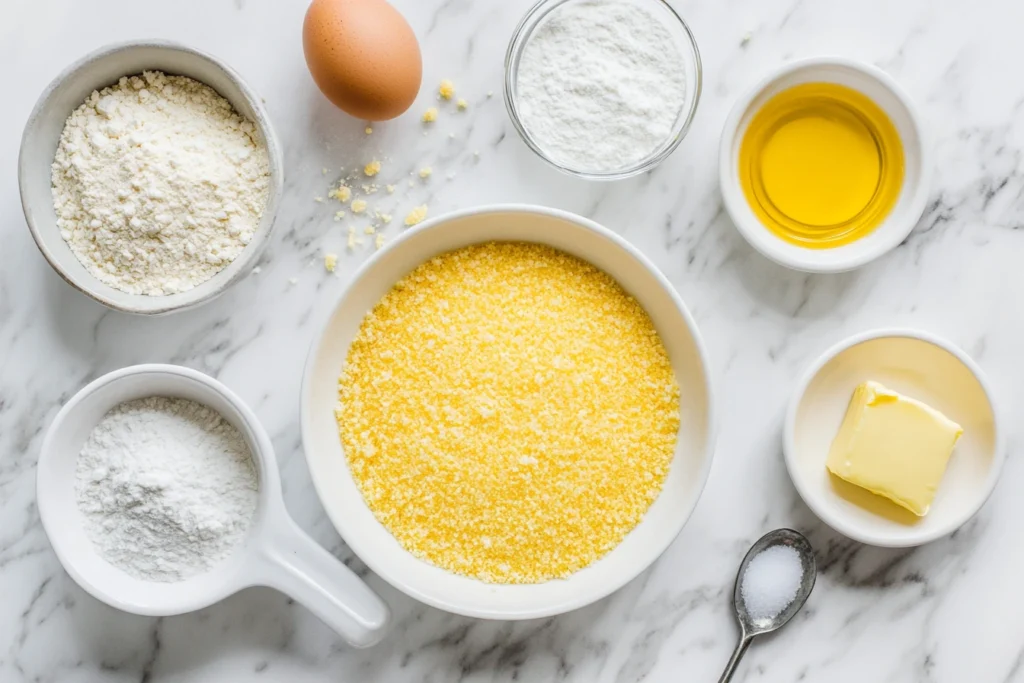
- 2 cups yellow cornmeal (stone-ground provides the best texture and flavor)
- 1 cup all-purpose flour
- 2 tablespoons sugar
- 1 tablespoon baking powder
- 1 teaspoon salt
- 1/4 teaspoon baking soda
- 2 large eggs, beaten
- 1 1/2 cups buttermilk
- 3 tablespoons melted butter
- 1/2 cup vegetable oil or bacon grease (for frying)
The Art of Ingredient Selection for Crispy Fried Cornbread
Cornmeal Considerations
The cornerstone of exceptional crispy fried cornbread is quality cornmeal. Stone-ground varieties offer superior texture and flavor compared to their more processed counterparts. The coarser grind provides pleasant textural contrast, while retaining more of the corn’s natural oils and flavor compounds.
Yellow cornmeal is traditional for crispy fried cornbread, but white cornmeal works equally well. Some regional variations even combine the two for a unique appearance. What’s most important is avoiding self-rising cornmeal unless you adjust the recipe accordingly (omitting the added leaveners).
The Role of Buttermilk in Crispy Fried Cornbread
Buttermilk serves multiple crucial functions in crispy fried cornbread. Beyond adding a pleasant tanginess, its acidity activates the baking soda, creating carbon dioxide bubbles that help leaven the batter. This chemical reaction results in a lighter texture. Additionally, the proteins in buttermilk help bind the batter together, while its fat content contributes to tenderness.
If buttermilk isn’t available for your crispy fried cornbread, a common substitute is regular milk with a tablespoon of white vinegar or lemon juice added. Allow this mixture to sit for 5-10 minutes before using to develop the acidity needed.
Frying Fats for the Perfect Crispy Exterior
The choice of frying medium significantly impacts the final flavor of your crispy fried cornbread. Bacon grease, the traditional option, imparts a smoky depth that complements the corn’s sweetness. Those seeking a more neutral foundation opt for vegetable oil or shortening. Clarified butter (ghee) offers another delicious alternative, providing richness without the risk of burning that comes with regular butter.
Whatever fat you choose for your crispy fried cornbread, temperature control remains essential. Too cool, and the cornbread absorbs excess oil; too hot, and the exterior burns before the interior cooks through.
Step-by-Step Instructions for Crispy Fried Cornbread
Preparing the Batter
Start by combining your dry ingredients in a large mixing bowl. Whisk together the cornmeal, flour, sugar, baking powder, salt, and baking soda until thoroughly integrated. This ensures even distribution of the leavening agents for proper rising in your crispy fried cornbread.

In a separate bowl, combine your wet ingredients. Beat the eggs lightly, then mix in the buttermilk and melted butter. The buttermilk is crucial here – it adds tanginess and reacts with the baking soda to create a tender texture in your crispy fried cornbread.
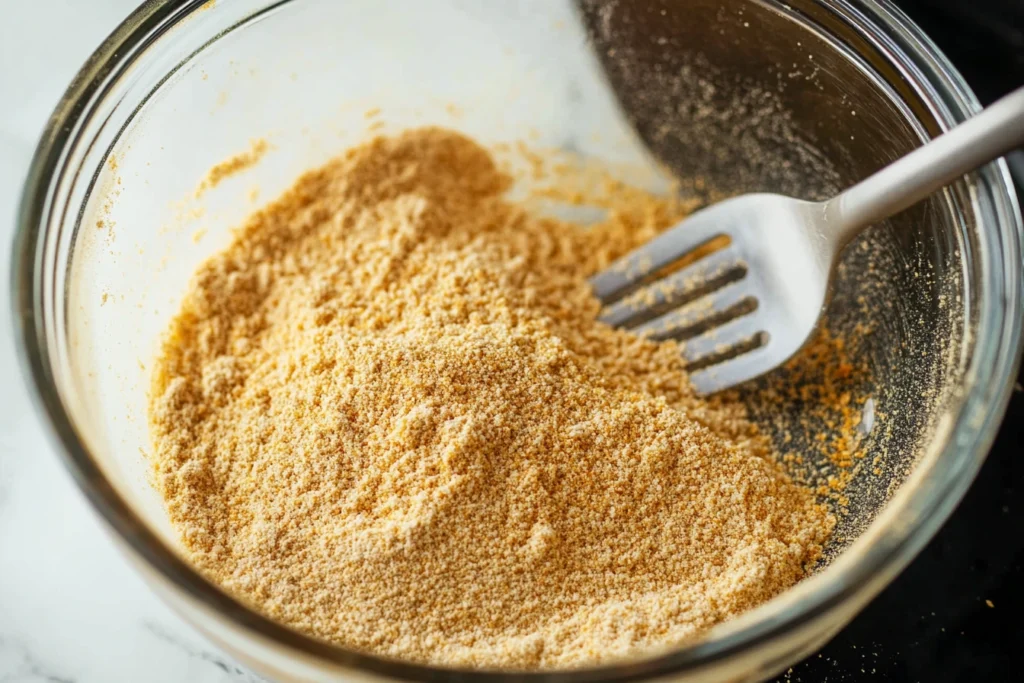
Pour the wet ingredients into the dry mixture and stir just until combined. This is a critical moment in the preparation – overmixing develops gluten, resulting in tough crispy fried cornbread. A few small lumps in the batter are perfectly acceptable and even desirable. The consistency should resemble thick pancake batter – fluid enough to spread slightly when poured but thick enough to hold its shape.
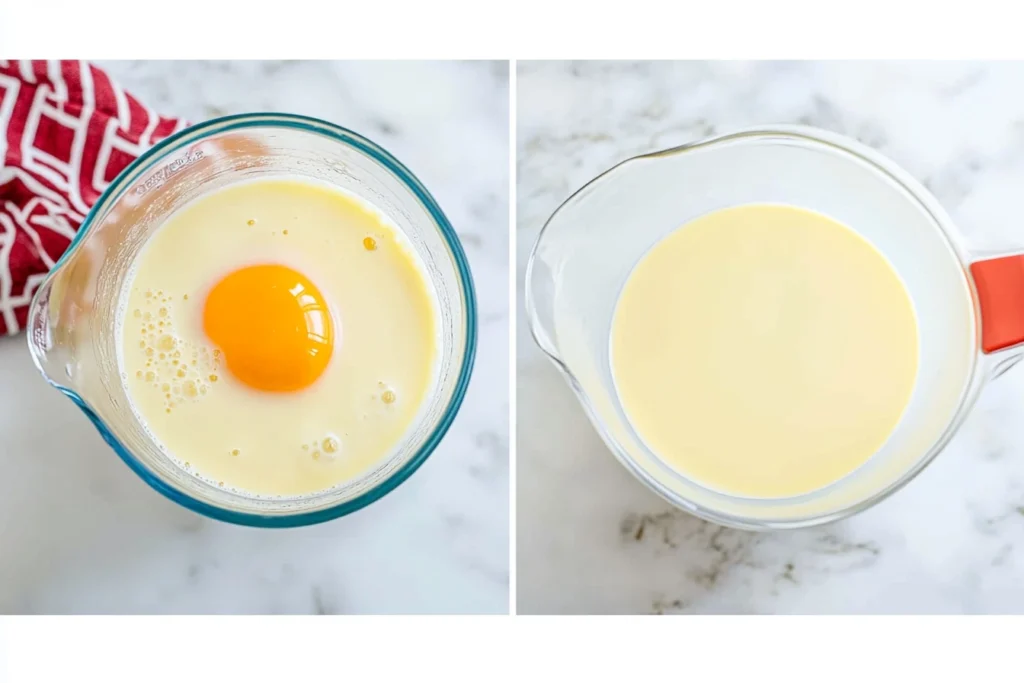
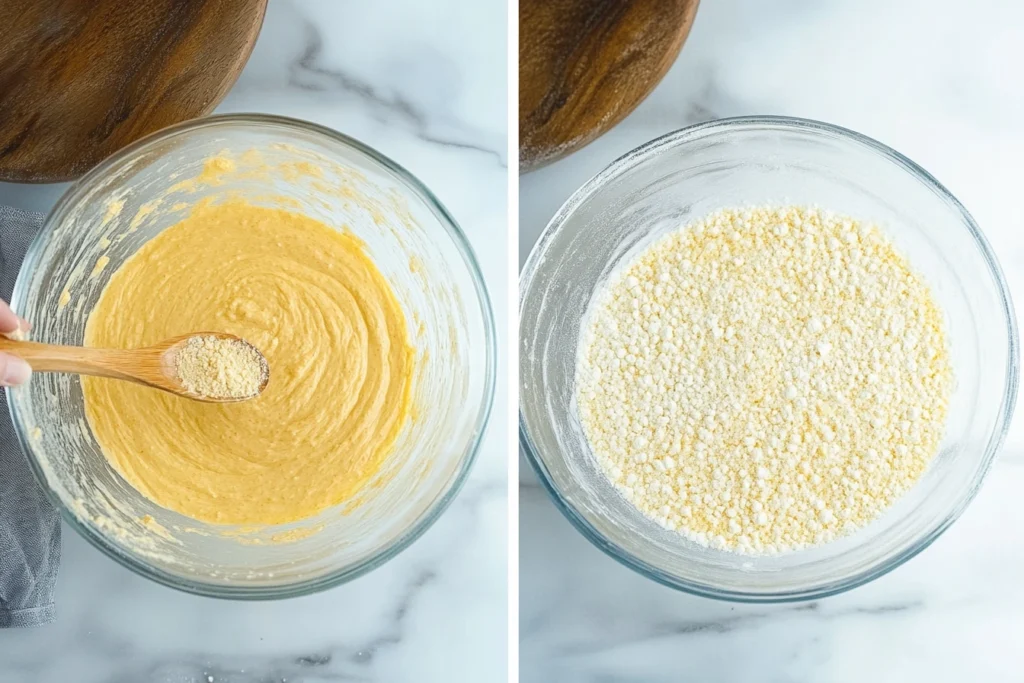
Allow the batter to rest for 5-10 minutes before cooking. This brief rest period gives the cornmeal time to hydrate and the leavening agents a head start on their work. You’ll notice the batter thickens slightly during this time.
The Frying Process for Crispy Fried Cornbread
Heat your choice of fat in a large, heavy skillet over medium heat. Cast iron is ideal for its heat retention and distribution properties, but any heavy-bottomed skillet will work. You’ll want about 1/4 inch of oil in the pan, heated to approximately 350°F. A sprinkle of cornmeal should sizzle immediately when the oil is ready – this simple test prevents the common pitfall of adding batter to insufficiently heated oil.
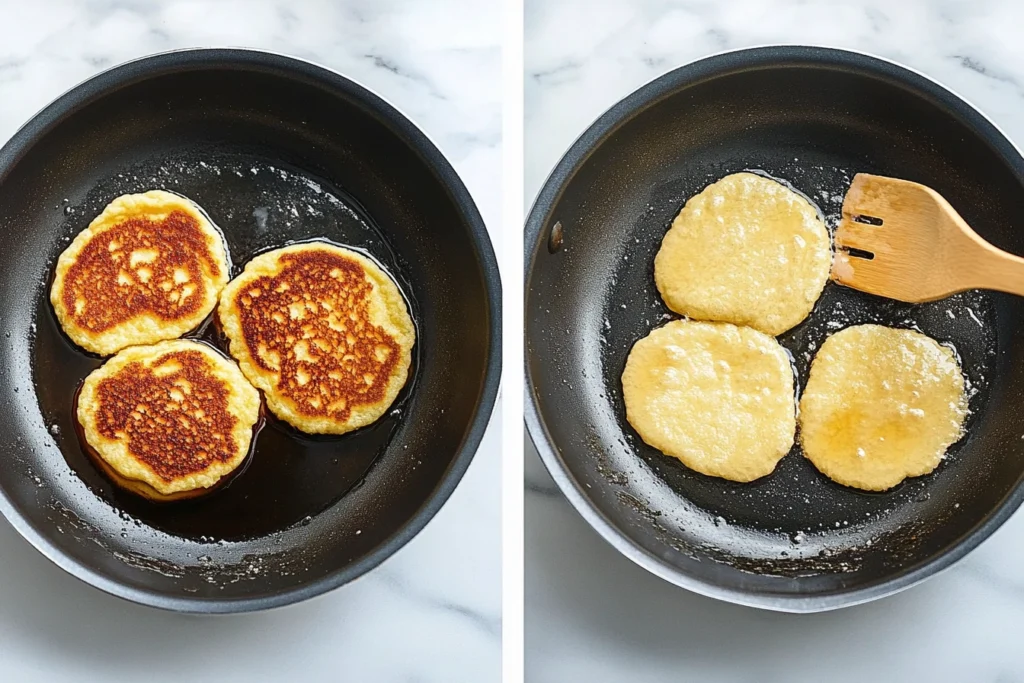
Using a 1/4 cup measure, carefully drop portions of batter into the hot oil, leaving enough space between them to allow for spreading. Don’t crowd the pan – work in batches if necessary. The crispy fried cornbread will begin to form bubbles around the edges as it cooks, a visual indicator that the leavening agents are activating.
Allow each piece of crispy fried cornbread to fry for 2-3 minutes, until the edges turn golden brown and crisp. Carefully flip each cake using a thin, flexible spatula. The flipping technique matters – abrupt movements can break delicate cakes. Instead, slide the spatula completely under each cake, lift gently, and turn with controlled precision.
Cook for another 2-3 minutes until the second side is equally browned and crisp. The interior should be cooked through but still moist – a toothpick inserted into the center should come out clean or with a few moist crumbs.
Transfer the crispy fried cornbread to a paper towel-lined plate to drain excess oil. Serve immediately while hot and crispy for the optimal texture contrast.
Perfect Pairings: Serving Suggestions for Crispy Fried Cornbread
Crispy fried cornbread shines as a versatile accompaniment to many dishes. Its slightly sweet corn flavor and textural contrast complement a wide range of flavors and cuisines.
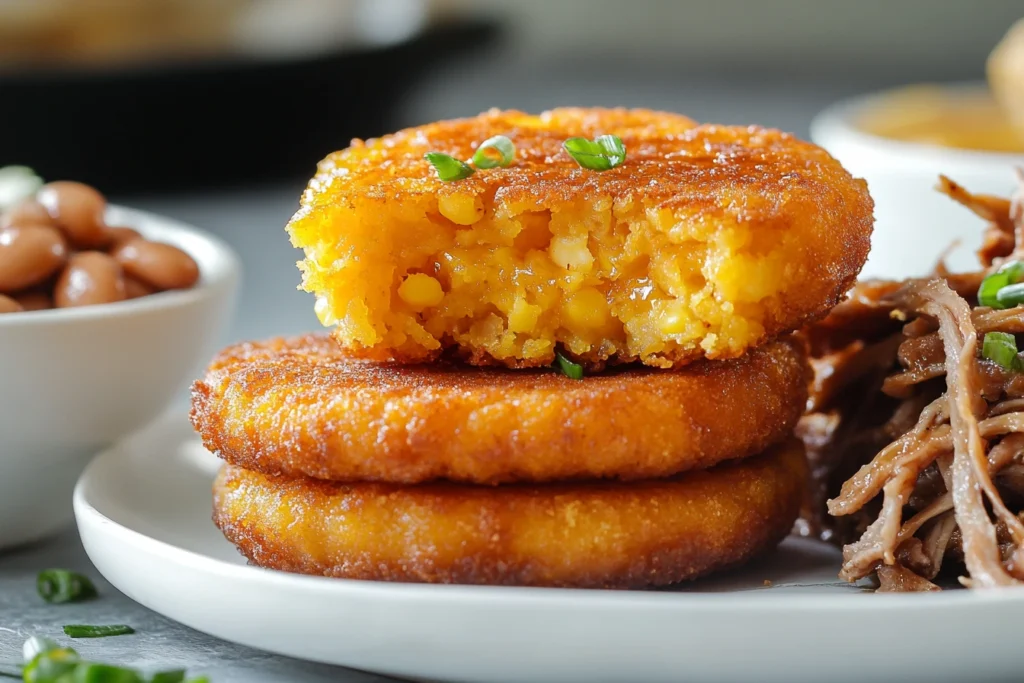
Traditional Southern Accompaniments
The most classic pairing is with slow-cooked vegetables, particularly greens. The subtle sweetness of the crispy fried cornbread balances perfectly with the earthy, sometimes bitter notes of collard greens, mustard greens, or turnip greens. The crispy edges are perfect for sopping up the flavorful pot liquor (the nutrient-rich cooking liquid from the greens).
Beans form another traditional pairing with crispy fried cornbread. Whether with pinto beans, black-eyed peas, or butter beans, crispy fried cornbread serves as both complement and utensil. The starchy beans and crispy cornbread create a complete protein profile together, explaining why this combination sustained generations of Southerners through lean times.
For breakfast, serve warm crispy fried cornbread with honey, sorghum syrup, or cane syrup for a sweet treat. Alternatively, top with a fried egg and hot sauce for a savory morning meal. Many Southerners enjoy it simply with a glass of cold buttermilk, creating a pleasing temperature and texture contrast.
Contemporary Serving Ideas
Modern interpretations extend beyond traditional pairings. Crispy fried cornbread makes an excellent base for Southwestern-inspired toppings such as avocado, pico de gallo, and crema. It pairs surprisingly well with barbecue, the sweetness balancing smoky, spicy notes.
In fusion cuisine, crispy fried cornbread can serve as a base for Asian-inspired flavors – try topping with pulled pork or duck in hoisin sauce with cucumber and scallions for a Southern-Asian fusion dish. The sturdy texture holds up well to saucy toppings without becoming soggy.
For entertaining, miniature versions of crispy fried cornbread make perfect cocktail party fare. Small dollar-sized cakes can be topped with pimento cheese, country ham, pepper jelly, or smoked salmon for sophisticated one-bite appetizers that honor Southern heritage while appealing to contemporary palates.
FAQs About Crispy Fried Cornbread
Why is my cornbread falling apart during frying?
This common issue usually happens when the batter is too wet. Add a bit more cornmeal, a tablespoon at a time, until it reaches a thicker consistency. Also, ensure your oil is hot enough before adding the batter, as proper initial cooking helps set the structure. The ideal temperature for frying is around 350°F – at this temperature, a small drop of batter should sizzle immediately when it hits the oil.
Can I make the batter ahead of time?
The batter can be made up to an hour ahead and left to rest, but the leavening agents will begin to lose effectiveness if left too long. A brief 5-10 minute rest actually improves the texture slightly as it allows the cornmeal to fully hydrate. If you need to prepare further in advance, mix the dry ingredients separately from the wet ingredients, then combine them just before cooking.
What’s the difference between fried cornbread and hoe cakes?
The terms are often used interchangeably, though traditionally, hoe cakes might be thinner and made with a simpler recipe. The name “hoe cake” comes from the old practice of cooking cornbread on the flat metal blade of a field hoe over an open fire when proper cooking implements were unavailable. Today, most cooks consider fried cornbread and hoe cakes to be essentially the same delicious dish.
Can I use self-rising cornmeal?
Yes, you can use self-rising cornmeal. If doing so, omit the baking powder, salt, and baking soda from the recipe as these leavening agents are already included in self-rising cornmeal. Be aware that self-rising products can lose potency over time, so freshness matters when making your cornbread.
Is fried cornbread gluten-free?
Standard recipes are not gluten-free due to the all-purpose flour. However, you can create gluten-free versions by substituting a gluten-free flour blend and ensuring your cornmeal is processed in a gluten-free facility. Many gluten-free bakers find that a combination of rice flour and tapioca starch works well as a substitute in these recipes.
How do I know when the oil is the right temperature?
The oil temperature is crucial for perfect results. If you don’t have a thermometer, you can test the oil by dropping a small amount of batter or a few cornmeal grains into the pan. If they sizzle immediately and rise to the surface, your oil is ready. If they sink and barely bubble, the oil is too cool. If they brown too quickly, the oil is too hot and should be allowed to cool slightly before cooking.
Can I freeze leftover fried cornbread?
Yes, fried cornbread freezes surprisingly well. Allow the cornbread to cool completely, then place pieces in a single layer on a baking sheet and freeze until solid. Transfer to an airtight container or freezer bag with parchment paper between layers. Frozen cornbread will maintain quality for up to three months. To reheat, place frozen pieces directly in a 350°F oven for 10-15 minutes until heated through and crispy again.
The Timeless Appeal of Crispy Fried Cornbread
Crispy fried cornbread stands as a testament to Southern ingenuity and the culinary art of transforming simple ingredients into extraordinary food. From its humble origins as a practical solution for hungry workers to its place on contemporary tables, this dish continues to satisfy and comfort generation after generation of food lovers.
The magic lies in its perfect balance of contrasts – the crispy exterior giving way to a tender interior, the subtle sweetness of corn complemented by savory notes from the frying medium, the humble ingredients creating a dish greater than the sum of its parts. This balance makes fried cornbread not just a side dish but often the highlight of the meal. It pairs beautifully with cowboy steak, adding a rustic and hearty element to any Southern-inspired dinner.
As Southern cuisine continues to gain appreciation worldwide, dishes like crispy fried cornbread serve as cultural ambassadors, telling the story of a region’s history, resourcefulness, and culinary wisdom. The simplicity belies its depth of flavor and the skill required to execute it perfectly – hallmarks of truly great cooking traditions worldwide. Pair it with dill pickle potato salad for a tangy contrast, or enjoy it alongside a bowl of creamy potato and hamburger soup for a cozy meal.
Whether you’re making cornbread from a recipe handed down through generations or trying it for the first time, you’re participating in a living culinary tradition. As you master the techniques and develop your own preferred variations, you connect with countless cooks who have stood at skillets before you, transforming cornmeal, buttermilk, and heat into something memorable and delicious. Consider serving it with smoked meatloaf or as a side for a Mississippi meatballs dish for a comforting Southern spread.
So heat up your skillet, prepare your batter, and join the long tradition of cornbread makers. In a world of complicated cooking techniques and exotic ingredients, there’s something profoundly satisfying about creating a dish that proves simple food, properly prepared, can be the most delicious of all. Whether you’re enjoying it with pistachio salad for a refreshing side or dipping it into crockpot creamy chicken pasta for added indulgence, crispy fried cornbread is a timeless delight.
Print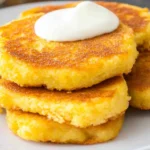
Crispy Fried Cornbread
- Total Time: 25
- Yield: 12 patties 1x
Description
This authentic crispy fried cornbread delivers the perfect contrast of golden, crispy exterior and tender, slightly sweet interior. A Southern classic that’s simple to make but packed with flavor, these cornbread patties are perfect alongside greens, beans, or drizzled with honey for a sweet treat.
Ingredients
- 2 cups yellow cornmeal
- 1 cup all-purpose flour
- 2 tablespoons sugar
- 1 tablespoon baking powder
- 1 teaspoon salt
- 1/4 teaspoon baking soda
- 2 large eggs, beaten
- 1 1/2 cups buttermilk
- 3 tablespoons melted butter
- 1/2 cup vegetable oil or bacon grease (for frying)
Instructions
- In a large bowl, whisk together cornmeal, flour, sugar, baking powder, salt, and baking soda until well combined.
- In a separate bowl, beat eggs lightly, then mix in buttermilk and melted butter until combined.
- Pour wet ingredients into dry ingredients and stir just until combined. Avoid overmixing – some small lumps are fine.
- Let batter rest for 5-10 minutes while heating oil.
- Heat oil in a cast-iron skillet over medium heat until a drop of batter sizzles immediately when added.
- Using a 1/4 cup measure, carefully drop portions of batter into the hot oil, leaving space between them.
- Cook for 2-3 minutes until edges are golden brown and bubbles form on the surface.
- Carefully flip each patty and cook another 2-3 minutes until golden brown on both sides.
- Transfer to a paper towel-lined plate to drain excess oil.
- Serve immediately while hot and crispy.
Notes
- For best flavor, use stone-ground cornmeal rather than degerminated cornmeal.
- Bacon grease adds wonderful flavor if you have it available.
- Don’t crowd the pan – fry in batches if necessary.
- Test oil temperature with a small drop of batter before cooking.
- These are best enjoyed immediately after cooking when they’re at their crispiest.
- For extra flavor, add 1/2 cup corn kernels or 1/4 cup chopped jalapeños to the batter.
- Prep Time: 10
- Cook Time: 15
- Category: Side Dish
- Method: Pan-Fried
- Cuisine: Southern
Nutrition
- Serving Size: 2 patties
- Calories: 345
- Sugar: 5g
- Sodium: 480mg
- Fat: 18g
- Saturated Fat: 5g
- Unsaturated Fat: 12g
- Trans Fat: 0g
- Carbohydrates: 42g
- Fiber: 3g
- Protein: 7g
- Cholesterol: 65mg
Keywords: crispy fried cornbread, southern cornbread, hoe cakes, skillet cornbread, fried cornbread patties, buttermilk cornbread

